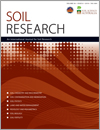SR18233Management of the major chemical soil constraints affecting yields in the grain growing region of Queensland and New South Wales, Australia – a review
 , R. C. Dalal
, R. C. Dalal  , J. B. Wehr, Y. P. Dang, P. M. Kopittke
, J. B. Wehr, Y. P. Dang, P. M. Kopittke  , G. Kirchhof, R. Fujinuma and N. W. Menzies
, G. Kirchhof, R. Fujinuma and N. W. Menzies
The profitable management of soil constraints is imperative in the grain growing region of New South Wales and Queensland, Australia. This paper consolidates information regarding the management of sodicity, salinity and acidity relevant to this region and identifies key knowledge gaps. This work helps to identify areas important for future research, which will enhance the ability of growers to profitably manage constrained soils for grains production.




